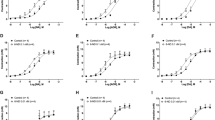Summary
The effect of pinacidil on the release of endogenous noradrenaline and dopamine from the sympathetic innervation of the rat vas deferens was examined. Amine release was evoked by electrical stimulation (1, 2, 5 and 10 Hz) or by depolarization with high potassium (75 mmol/l) in the medium. Dopamine and noradrenaline were measured by means of high pressure liquid chromatography with electrochemical detection.
Pinacidil (1, 5, 10 and 50 μmol/l) produced a concentration-dependent inhibition of the electrically stimulated (2 Hz) overflow of noradrenaline and dopamine. Only pinacidil 50 μmol/l increased the spontaneous loss of dopamine and noradrenaline. The inhibitory effects of pinacidil (5 μmol/l) on amine overflow were also observed at other frequencies of stimulation (1, 5 and 10 Hz). The magnitude of the inhibitory effect on noradrenaline release was approximately the same at all frequencies (63% to 56% reduction); for dopamine, the higher the frequency of stimulation, the greater the inhibitory effect of pinacidil (up to 73% reduction). When the preparations were continuously stimulated for 70 min at 2 Hz, pinacidil (5 μmol/l) reduced the overflow of dopamine and noradrenaline during the first 40 or 30 min of stimulation only. The addition of phentolamine (1 μmol/l) to the perifusion medium slightly reduced the inhibitory effect of pinacidil on amine overflow, but the inhibition by pinacidil remained statistically significant. Tetraethylammonium (10 mmol/l) completely abolished the inhibitory effect of pinacidil (10 μmol/l). Pinacidil (5 μmol/l) did not reduce the potassium-evoked release of the amines.
The results demonstrate that pinacidil impairs transmitter release from the sympathetic innervation of the rat vas deferens, probably as a consequence of the opening of potassium channels.
Similar content being viewed by others
References
Ahnfelt-Ronne I (1988) Pinacidil: History, basic pharmacology, and therapeutic implications. J Cardiovasc Pharmacol 12 (Suppl. 2):S1-S4
Alzheimer C, Bruggencate G (1988) Actions of BRL34915 (cromakalim) upon convulsive discharges in guinea pig hippocampal slices. Naunyn-Schmiedeb erg's Arch Pharmacol 337:429–434
Arrigoni-Martelli E, Nielsen CK, Olsen UBB, Petersen HJ (1980) N′-cyano-N-4-pyridil-N′-1,2,2-trimethylpropylguanidine monohydrate (P1134), a new potent vasodilator. Experientia 36:445–447
Bowman WC (1982) Aminopyridines: their pharmacological actions and potential clinical uses. Trends Pharmacol Sci 3:183–185
Cook N (1988) The pharmacology of potassium channels and their therapeutic potential. Trends Pharamcol Sci 9:21–28
Hall AK, Maclagan J (1988) Effect of cromakalim on cholinergic neurotransmission in the guinea-pig trachea. Br J Pharmacol 95:792P
Heepe P, Starke K (1985) α-adrenoceptor antagonists and the release of noradrenaline in rabbit cerebral cortex slices: support for the α-adrenoceptor hypothesis. Br J Pharmacol 84:147–155
Hermsmeyer RK (1988) Pinacidil actions on ion channels in vascular muscle. J Cardiovasc Pharmacol 12 (Suppl. 2):S17-S22
MacPherson GA, Angus JA (1989) Phentolamine and structurally related compounds selectively antagonize the vascular actions of the K+ channel opener, cromakalim. Br J Pharmacol 97:941–949
Racks K, Altes U, Baur AM, Hobbach HP, Jost D, Schäffer J, Wammack R (1988) Differential effects of potassium channel blockers on neurohypophysial release of oxytocin and vasopressin. Evidence for frequency-dependent interaction with the endogenous opiod inhibition of oxytocin release. Naunyn-Schmiedeberg's Arch Pharmacol 338:560–566
Schwörer H, Kilbinger H (1988) Effects of cromakalim on acetylcholine release and smooth muscle contraction in guinea-pig small intestine. Naunyn-Schmiedeberg's Arch Pharmacol 339:706–708
Soares-da-Silva P (1987) A comparison between the pattern of dopamine and noradrenaline release from sympathetic neurones of the dog mesenteric artery. Br J Pharmacol 90:91–98
Soares-da-Silva P (1988a) Evidence for dopaminergic co-transmission in dog mesenteric arterial vessels. Br J Pharmacol 95:218–224
Soares-da-Silva P (1988b) Dopamine and noradrenergic transmission. In: Vanhoutte PM (ed) Vasodilatation: Vascular smooth muscle, peptides, autonomic nerves and endothelium. Raven, New York, pp. 187–195
Soares-da-Silva P (1988c) Dopamine storage in sympathetic nerves. In: Bell C, McGrath B (eds) Peripheral actions of dopamine. MacMillan, London, pp. 24–40
Sokal RR, Rohlf FJ (1981) Biometry. The principles and practice of statistics in biological research. Freeman, New York
Starke K, Göthert M, Kilbinger H (1989) Modulation of neurotransmitter release by presynaptic autoreceptors. Physiol Rev 69:864–989
Thoolen MJMC, Van Meel JCA, Wilffert B, Timmermans PBMWM, van Zwieten PA (1983) Hemodynamic characterization of pinacidil in rats. Comparison with hydralazine. Pharmacology 27:245–254
Tsien RW, Lipscombe D, Madison DV, Bley KR, Fox AP (1988) Multiple types of neuronal calcium channels and their selective modulation. Trends Neurosci 11:431–438
Wakade AR (1980) A maximum contraction and substantial quantities of tritium can be obtained from tetraethylammonium-treated [3H]-noradrenaline preloaded, rat vas deferens in response to a single electrical shock. Br J Pharmacol 68:425–436
Weston AH, Southerton JS, Bray KM, Newgreen DT, Taylor SG (1988) The mode of action of pinacidil and its analogs P1060 and P1368: Results of studies in rat blood vessels. J Cardiovasc Pharmacol 12 (Suppl 2):S10-S16
Author information
Authors and Affiliations
Additional information
Send offprint request to P. Soares-da-Silva at the above adress
Rights and permissions
About this article
Cite this article
Soares-da-Silva, P., Fernandes, M.H. Inhibition by the putative potassium channel opener pinacidil of the electrically-evoked release of endogenous dopamine and noradrenaline in the rat vas deferens. Naunyn-Schmiedeberg's Arch Pharmacol 342, 415–421 (1990). https://doi.org/10.1007/BF00169458
Received:
Accepted:
Issue Date:
DOI: https://doi.org/10.1007/BF00169458




